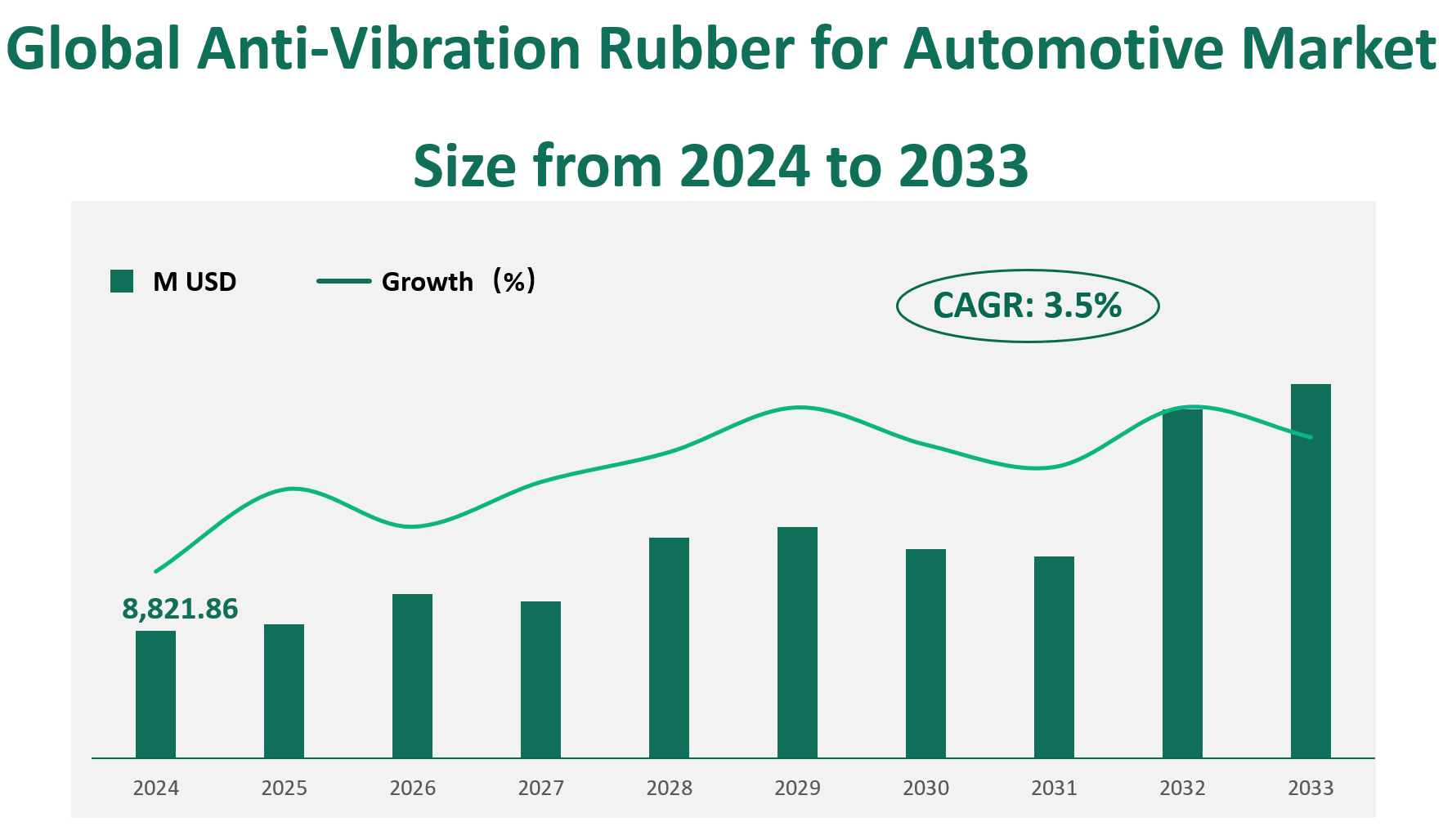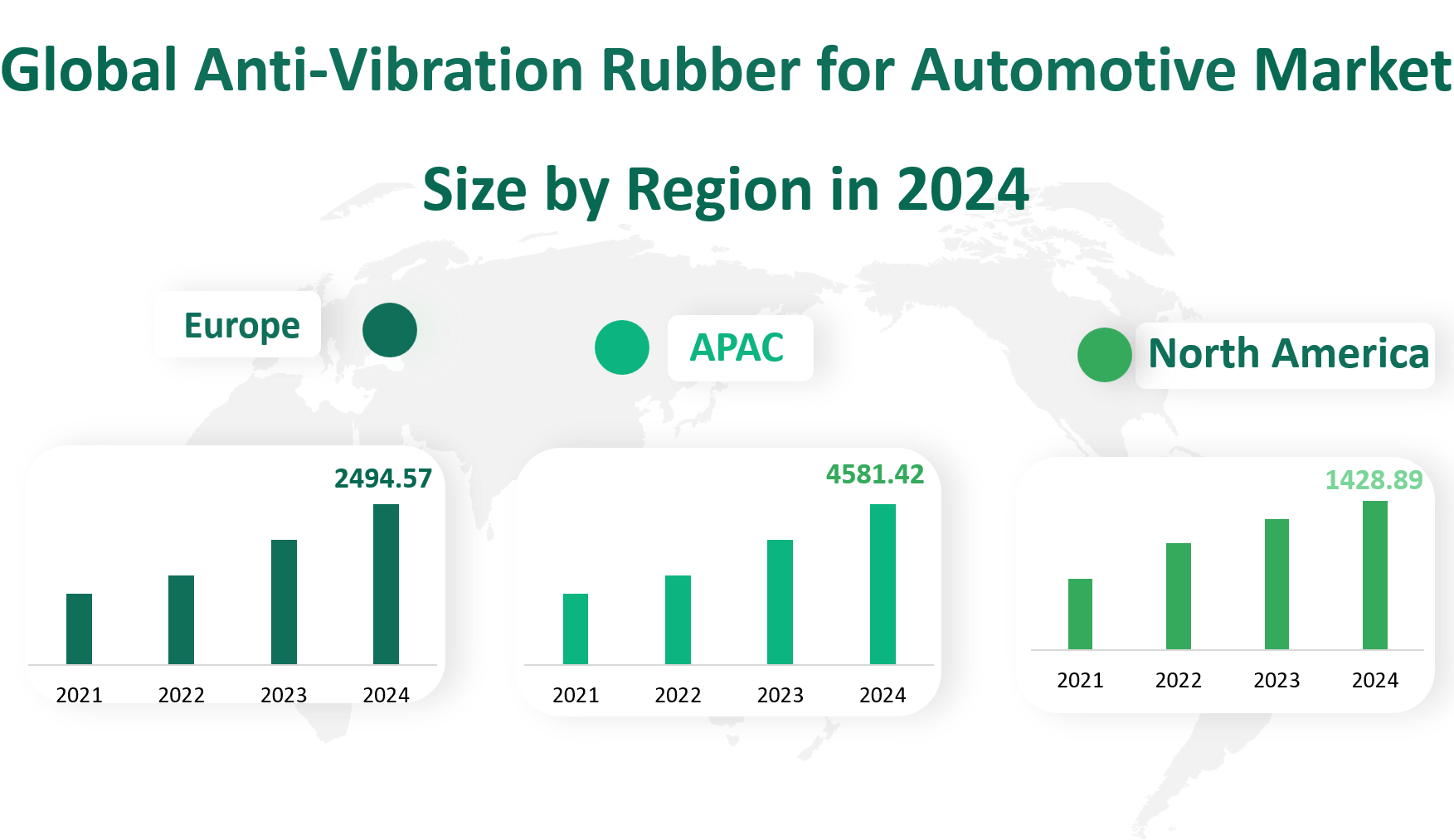1. Global Anti-Vibration Rubber for Automotive Market Insight Analysis
The global Anti-Vibration Rubber for Automotive market is projected to reach a value of $8,821.86 million USD in 2024, with a Compound Annual Growth Rate (CAGR) of 3.5% over the next few years.
Anti-Vibration Rubber for Automotive is a critical component used in various parts of automobiles to absorb vibrations and reduce noise transmission. These rubber components play a vital role in enhancing the comfort and quietness of vehicles. They are essential in applications such as engine mounts, suspension bushings, and chassis components, where they help to isolate vibrations and improve overall vehicle dynamics. The market for these products is influenced by several factors, including advancements in automotive technology, regulatory requirements for noise and vibration control, and the growing demand for electric vehicles, which have different vibration management needs compared to traditional internal combustion engine vehicles.
Figure Global Anti-Vibration Rubber for Automotive Market Size (M USD) and CAGR (2024-2033)

2. Driving and Limiting Factors of Anti-Vibration Rubber for Automotive Market Growth
The growth of the Anti-Vibration Rubber for Automotive market is driven by several key factors. Firstly, the increasing demand for high-quality anti-vibration solutions in the automotive industry is a significant driver. As vehicles become more complex and consumers demand higher levels of comfort and safety, the need for effective vibration control technologies has grown. Additionally, the rapid development of the electric vehicle (EV) market is a major driving force. Electric vehicles require specialized anti-vibration solutions due to their unique powertrain configurations, which generate different vibration patterns compared to conventional vehicles. The global push towards sustainable transportation and the adoption of stricter emission regulations have further boosted the demand for anti-vibration rubber components.
However, the market also faces several limiting factors. One of the primary challenges is the decline in global car sales, which has been exacerbated by economic downturns and trade uncertainties. The instability in the global economic environment has led to reduced consumer spending on automobiles, thereby affecting the demand for anti-vibration rubber products. Additionally, fluctuations in raw material prices pose a significant threat to manufacturers. Rubber, being a key raw material, is subject to price volatility due to supply and demand dynamics, as well as changes in global economic conditions. This volatility can increase production costs and reduce profit margins for manufacturers.
3. Technology Innovation and Corporate Mergers and Acquisitions in Anti-Vibration Rubber for Automotive Market
Technological innovation plays a crucial role in the Anti-Vibration Rubber for Automotive market. Advances in material science have led to the development of rubber compounds with enhanced properties, such as improved durability, resistance to high and low temperatures, and better dynamic fatigue performance. These innovations are essential for meeting the stringent requirements of modern automotive applications, especially in the context of electric vehicles. Companies are also investing in research and development to create rubber materials that are more environmentally friendly and sustainable, aligning with the broader trend towards green technologies in the automotive sector.
Corporate mergers and acquisitions have been a significant trend in the industry, as companies seek to expand their market share and enhance their technological capabilities. For example, Henniges Automotive was acquired by AVIC Automotive Systems Holding Co., Ltd., a subsidiary of the Aviation Industry Corporation of China, in 2015. This acquisition allowed Henniges to leverage AVIC’s resources and expand its presence in the global market. Similarly, Continental AG’s acquisition of Cooper-Standard’s anti-vibration business in 2018 further consolidated the market and provided Continental with additional manufacturing capabilities and intellectual property.
4. Global Anti-Vibration Rubber for Automotive Market Size by Type
The Anti-Vibration Rubber for Automotive market is categorized into several product types, each serving distinct functions in the automotive industry. These product types include Mounts, Bearings, Pads, Bushes, and Others.
Mounts are essential components that provide support and isolation for various parts of the vehicle, particularly the engine and other heavy machinery. They are designed to absorb vibrations and reduce noise transmission, ensuring a smoother ride. In 2024, the market value for Mounts is forecasted to be approximately 3328.85 million USD. Mounts have consistently held a significant market share due to their critical role in reducing vibrations from the engine and other mechanical parts.
Bearings are another crucial component in the Anti-Vibration Rubber for Automotive market. They are used to support the mechanical rotating body, reduce friction, and ensure rotation accuracy. The market value for Bearings in 2024 is projected to be around 1444.59 million USD.
Pads are designed to isolate high-frequency vibrations and noise, particularly in machinery that generates such vibrations. They are typically used in areas where high-frequency vibrations need to be minimized to ensure a quiet and comfortable ride. The market value for Pads in 2024 is estimated to be 1528.81 million USD. Pads have seen a consistent increase in demand due to their effectiveness in reducing high-frequency vibrations and noise.
Bushes are flexible interfaces between rigid parts, acting as buffers to absorb and dampen energy generated by interactions between these parts. They are crucial for maintaining the integrity of the vehicle’s suspension system and ensuring a smooth ride. The market value for Bushes in 2024 is forecasted to be 1540.91 million USD.
Table Global Anti-Vibration Rubber for Automotive Market Size by Type in 2024
|
Market Size (M USD) 2024 | |
|
Mounts |
3328.85 |
|
Bearings |
1444.59 |
|
Pads |
1528.81 |
|
Bushes |
1540.91 |
|
Others |
978.69 |
5. Global Anti-Vibration Rubber for Automotive Market Size by Application
The Anti-Vibration Rubber for Automotive market is primarily applied in two major segments: Passenger Vehicles and Commercial Vehicles.
Passenger Vehicles include cars, SUVs, and other light-duty vehicles designed for personal use. These vehicles require anti-vibration rubber components to ensure a comfortable and quiet ride, especially as consumer expectations for vehicle comfort and performance continue to rise. In 2024, the market value for anti-vibration rubber components in Passenger Vehicles is forecasted to be 6483.19 million USD.
Commercial Vehicles encompass trucks, buses, and other heavy-duty vehicles used for transportation and logistics. These vehicles require robust anti-vibration solutions to withstand the rigors of heavy use and long distances. The market value for anti-vibration rubber components in Commercial Vehicles in 2024 is projected to be 2338.67 million USD.
Table Global Anti-Vibration Rubber for Automotive Market Size by Application in 2024
|
Application |
Market Size (M USD) 2024 |
|
Passenger Vehicle |
6483.19 |
|
Commercial Vehicle |
2338.67 |
6. Global Anti-Vibration Rubber for Automotive Market by Top Regions
North America is a key market for anti-vibration rubber components, driven by the high demand for advanced automotive technologies and stringent safety regulations. In 2024, the market value in North America is forecasted to reach 1428.89 million USD.
Europe is another significant market, characterized by a mature automotive industry and a high demand for high-quality anti-vibration solutions. The market value in Europe is projected to be 2494.57 million USD in 2024. European manufacturers are known for their emphasis on vehicle dynamics and comfort, driving the demand for advanced anti-vibration rubber components.
The Asia Pacific region is the largest market for anti-vibration rubber components, driven by rapid industrialization, urbanization, and the growing automotive sector. In 2024, the market value in Asia Pacific is expected to reach 4581.42 million USD.
The Middle East and Africa market is relatively smaller but growing steadily. In 2024, the market value is forecasted to be 117.04 million USD.
South America is another emerging market, with a projected market value of 199.93 million USD in 2024.
Figure Global Anti-Vibration Rubber for Automotive Market Size by Region in 2024

7. Global Anti-Vibration Rubber for Automotive Market Analysis by Major Players
1. Sumitomo Riko
Company Introduction and Business Overview
Sumitomo Riko is a leading manufacturer of rubber and synthetic resin products, with a strong presence in the automotive industry. Established in 1929, the company is headquartered in Japan and operates manufacturing plants primarily in Asia. Sumitomo Riko supplies a wide range of anti-vibration rubber products to major automakers worldwide.
Products Offered
Sumitomo Riko offers a comprehensive range of anti-vibration rubber products, including engine mounts, suspension bushes, and strut mounts. Their products are designed to provide superior flexibility, damping, and reliability, effectively reducing vibrations and noise in vehicles.
7.2 Bridgestone
Company Introduction and Business Overview
Bridgestone is a global leader in the production of tires and automotive accessories. Established in 1931, the company is headquartered in Japan and operates manufacturing plants in the Americas, Asia Pacific, and Europe. Bridgestone’s diverse product portfolio includes anti-vibration rubber components, which are integral to their automotive offerings.
Products Offered
Bridgestone offers a range of anti-vibration rubber products, including engine mounts and suspension components. These products are designed to reduce engine vibration, noise transmission, and oscillation, ensuring a smoother ride for passengers.
7.3 Boge
Company Introduction and Business Overview
Boge Rubber and Plastics is a renowned manufacturer of vibration control technology and lightweight components for the automotive industry. Established in 1931, the company has manufacturing plants in Europe, the Americas, and Asia Pacific. Boge is known for its high-quality and durable anti-vibration rubber products.
Products Offered
Boge offers a range of anti-vibration rubber products, including rubber-metal technology and NVH car chassis components. Their products are designed to reduce vibrations and improve vehicle dynamics and comfort.

